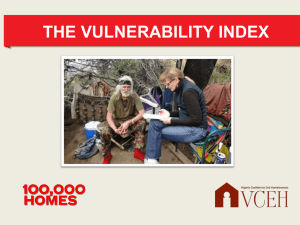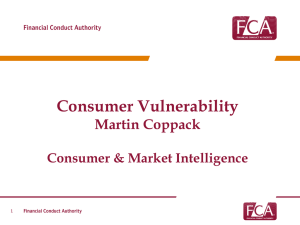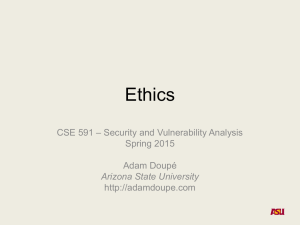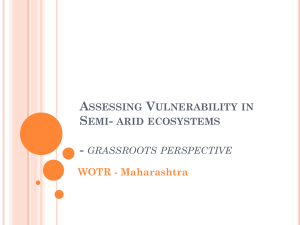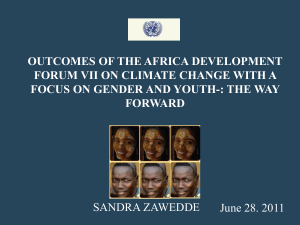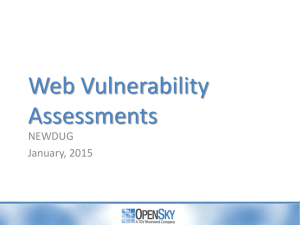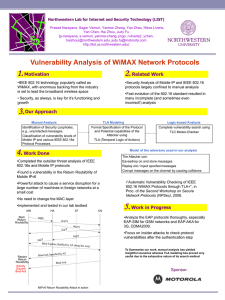Vulnerability of coupled human-environment systems
advertisement
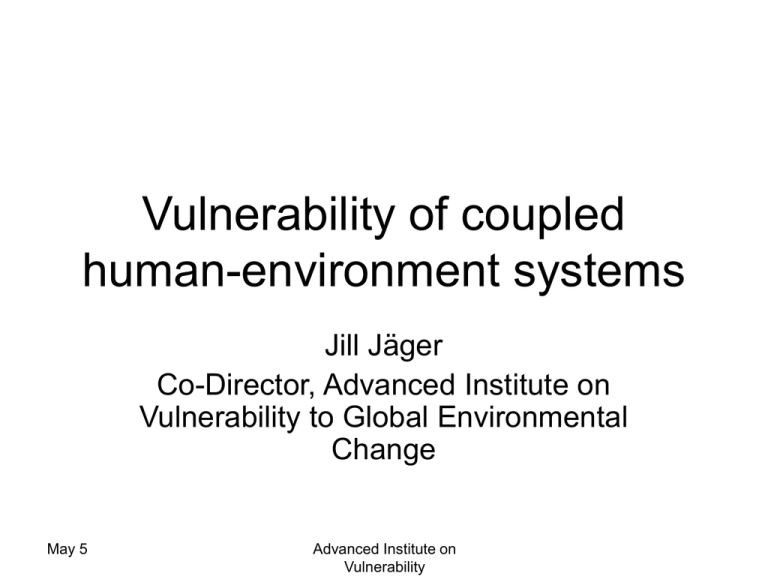
Vulnerability of coupled human-environment systems Jill Jäger Co-Director, Advanced Institute on Vulnerability to Global Environmental Change May 5 Advanced Institute on Vulnerability The Vulnerability of Coupled Human-Environment Systems • Who and what are vulnerable to the multiple environmental and human changes underway, and where? • How are these changes attenuated or amplified by different human and environmental conditions? • What can be done to reduce vulnerability to change? • How may more resilient and adaptive communities be built? May 5 Advanced Institute on Vulnerability The Emergence of Vulnerability Analysis • Vulnerability is the degree to which a system, subsystem, or system component is likely to experience harm due to exposure to a hazard, either a perturbation or stressor/stress • This definition is not new. It has emerged from sustained research and practice on risks and hazards, climate impacts, and resilience May 5 Advanced Institute on Vulnerability Risk – Hazard Models • Sought to understand the impact of a hazard as a function of exposure to the hazard event and the dose-response (sensitivity) of the entity exposed • Past applications generally worked from the hazard to the impact(s) • In some cases vulnerability was explicitly addressed May 5 Advanced Institute on Vulnerability May 5 Advanced Institute on Vulnerability Inadequacies of the Risk-Hazard Framework Does not address: • The ways the system amplifies or attenuates the impacts of the hazard • Distinctions among exposed subsystems and components that lead to significant variations in the consequences of the hazard • The role of political economy (especially social structures and institutions) in shaping differential exposure and consequences May 5 Advanced Institute on Vulnerability Pressure and Release Models • Risk defined as a function of perturbation (stress) and vulnerability of the exposure unit • Asks what conditions make exposure unsafe and what causes these conditions • Used primarily to address social groups facing disaster events • Does not address the coupled humanenvironment system (i.e. not biophysical subsystems), or hazard causal sequence; underemphasizes feedbacks May 5 Advanced Institute on Vulnerability The Vulnerability Framework • Draws on the concepts of – Entitlement – Coping through diversity – Resilience • Entitlements: Legal and customary rights to exercise command over food and other necessities of life. Determined by units‘ endowments (what they have to sell and the price received), the cost of food relative to endowments, access to markets and resources. May 5 Advanced Institute on Vulnerability Coping Capacity • Linked to entitlements and endowments • Societal „safety nets“ empower coping capacity • Diversification is an overarching strategy aimed at reducing risks and increasing options in the face of hazards • Much depends on social, economic, institutional, and political structures May 5 Advanced Institute on Vulnerability Resilience • A system‘s ability to bounce back to a reference state after a disturbance • Or, the capacity of a system to maintain certain structures and functions despite disturbance • How much change can a given system undergo and still remain within the set of natural or desirable states? • Explicit incorporation of differential resilience has become a critical element of analysis of humanenvironment systems May 5 Advanced Institute on Vulnerability Expanded Vulnerability Analysis • Multiple interacting perturbations and stressors/stresses and their sequencing • Exposure beyond the presence of perturbations • Sensitivity of the coupled system to the exposure • System‘s capacity to cope or respond • System‘s restructuring after the responses (adjustment or adaptation) • Nested scales and scalar dynamics of hazards, coupled systems and responses May 5 Advanced Institute on Vulnerability Useful for decision-making (1) • Consider the outcomes to be avoided (working backwards to the perturbation or stressor) – stakeholder input • Profile differential vulnerability • Cognizant of stochastic and non-linear elements operating on and within the coupled system (surprise) May 5 Advanced Institute on Vulnerability Useful for decision-making (2) • Consider role of institutions (stresses, sensitivity, resilience) • Identify suspect causal structures and test cause-and-effect links • Develop metrics and measures for assessments, models and tests • Develop institutional structures for linking vulnerability analyses to decision-making May 5 Advanced Institute on Vulnerability „Place-based“ Approaches • Strong variation in vulnerability by location elevates the role of „place-based“ analysis • Link to other places and scales of analysis • Need to find methods to operationalize vulnerability analysis that are useful for specificity of place and for building general concepts from them • Methodological approaches include „degradation syndrome“, complex indicator approaches, integrated modeling and simulation, statistical downscaling May 5 Advanced Institute on Vulnerability The Vulnerability Framework • Real world data and other constraints require „reduced“ vulnerability assessment • Needs to be aware of different spatiotemporal scales May 5 Advanced Institute on Vulnerability The Basic Architecture • Linkages to broader human and environmental conditions and processes (black, top and bottom) • Perturbations and stressors/stress (red,left) • Coupled human-environment system in which vulnerability resides, including exposure and responses (blue, centre) • Spatial scale – place (blue), region (yellow), globe (green) May 5 Advanced Institute on Vulnerability May 5 Advanced Institute on Vulnerability May 5 Advanced Institute on Vulnerability Lessons • Human and biophysical vulnerability are linked and should be treated accordingly • Beware of one-dimensional vulnerability analysis • Broadly similar coupled systems do not necessarily have the same vulnerabilities • All parts of the coupled system do not necessarily have the same vulnerability • Vulnerability assessments should follow a common general methodological framework • Critical response options are place-dependent • Need to link vulnerability analysis to decision-making May 5 Advanced Institute on Vulnerability May 5 Advanced Institute on Vulnerability Reflections on the Vulnerability Framework • Full vulnerability assessment is difficult because of complexity of factors, processes and feedbacks • Difficulties amplified by scalar dynamics • Framework provides useful point of departure • Helps identify gaps in understanding and different stakeholder views May 5 Advanced Institute on Vulnerability From the Case Studies • Case studies show the complexity of exposure, sensitivity and resilience • In each case, external political and economic forces are reshaping regional and local environmental uses and coping capacities • Local stakeholders voice different concerns about these changes and are active agents responding differently based on their individual understanding and capacities May 5 Advanced Institute on Vulnerability


